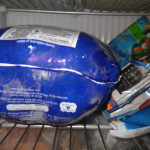 Dig around in your freezer. Is there a turkey in there? Perhaps you got it as a gift last Christmas or at a great price after Thanksgiving last year. You just didn’t get around to cooking it throughout the year. So you wonder. Is it safe to use for Thanksgiving dinner this year.
Dig around in your freezer. Is there a turkey in there? Perhaps you got it as a gift last Christmas or at a great price after Thanksgiving last year. You just didn’t get around to cooking it throughout the year. So you wonder. Is it safe to use for Thanksgiving dinner this year.
In general the answer is YES.
There are a couple of caveats. Was the bird solidly frozen the whole time? The temperature in the freezer needs to have been constant during the year and the wrappings should be intact. Did you have any major power outages during this past year where the turkey could have thawed partially or completely? Since it takes several days for a turkey to thaw this is probably unlikely, but the safety key is that the bird was kept below 40 degrees the whole time the power was off.
A turkey kept for a year in a freezer will be safe. But (always a disclaimer) it might have some quality loss. This could be a texture change or an off-flavor. You might not want to risk it on the big day. So, it might be a good idea to buy a new turkey for the holiday and use the stored bird for a family meal earlier in the month.
Since obviously if there’s a year-old turkey in your freezer, you don’t cook a turkey very often, it’ll also be a good “run through” meal before the holiday.
Here are a couple of tips to get you started:
- When buying a whole turkey allow for about 1 pound per person. This will give you plenty of leftovers for sandwiches.
- It takes a day for each five pounds of turkey to thaw in the refrigerator.
- Don’t rely on the pop-up thermometer in the turkey. If you don’t have one, treat yourself to an instant-read food thermometer. If you have one, this might be a good time to calibrate it. Put it in a glass of ice water and see if it is accurate. No sense in using it if it’s wrong.
- The lowest oven temperature you should use to cook a turkey is 325 degrees. Lower that that will allow the turkey to stay in the temperature danger zone for a long period of time and may result in a food borne illness.
- Consider not stuffing the bird. An unstuffed turkey will cook faster and maybe safer. Think about it….where are you putting that stuffing? Why do you think it is so moist? Cooking the stuffing in a separate dish also allows you to control the fat and calories that are absorbed into the stuffing.
- If you decide to stuff, allow about ¾ cup stuffing for each pound of turkey. Stuff the bird just before putting it in the oven. Stuffing it the day before is just asking for food safety problems.
- Allow at least 20 minutes a pound for roasting and then some resting time before serving.
- Check the temperature of the turkey in several spots. You’ll hear lots of temperatures being suggested in recipes and by television chefs. Some people like the texture of turkey when it is cooked to a higher temperature and that’s OK, but for food safety make sure it is at least 165 degrees. If you do stuff the turkey, make sure the stuffing (deep down inside the cavity) is also 165 degrees, too.
Getting that frozen turkey out of the freezer will free up some space for leftovers or perhaps another turkey that you’ll get on sale this year. Perhaps this year you’ll get around to cooking turkey more often. It’s not that hard. I, personally, think that the turkey is the easiest part of the Thanksgiving dinner.
Cheryle Jones Syracuse, MS
Professor Emeritus, The Ohio State University